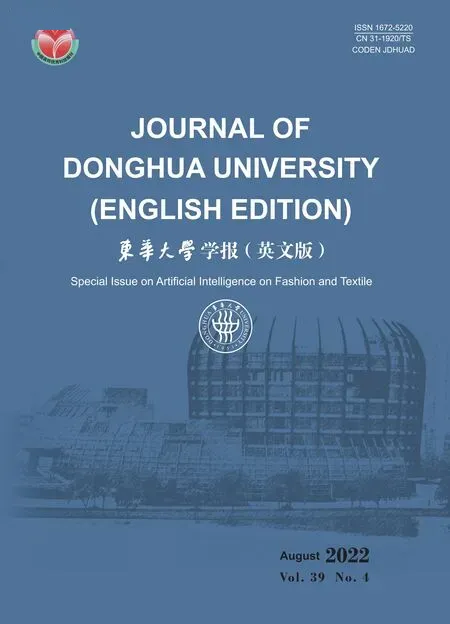Design and Development of Garment Fabric Database Management System
2022-09-28DUJianxia杜剑侠LIUZhengdong刘正东GENGZengmin耿增民
DU Jianxia(杜剑侠), LIU Zhengdong(刘正东), GENG Zengmin(耿增民)
1 School of Fashion, Beijing Institute of Fashion Technology, Beijing 100029, China
2 School of Arts and Sciences, Beijing Institute of Fashion Technology, Beijing 100029, China
Abstract: The main performance characteristics of garment fabric are analyzed and extracted, which include physical characteristics, appearance characteristics and subjective evaluation characteristics. A calculating model of fabric’s subjective evaluation is provided, which can be adjusted as the data increasing. The database system of garment fabric is analyzed, and then function design, concept design and logic design are carried out. The user interface(UI) design of garment fabric database system is described. The system can not only serve the fabric management and customization of garment enterprises, but also serve the teaching work of colleges and universities, because it is rich in information and convenient. It is of great significance to digital construction in the clothing field.
Key words: fabric physical characteristic; subjective evaluation model of fabric; fabric database design; concept design; logic design
Introduction
With the popularization of industry 4.0, the intelligence and personalized customization of clothing production has become an inevitable way of clothing enterprise reform. Garment fabric is an important part of garment function and performance. The construction of garment fabric database system plays an important role in intelligent and customized garment production. Based on the needs of teaching and routine production management, colleges and universities as well as various garment enterprises mostly have their own fabric database systems, such as Textile Fabric Inquiry System developed by Northwest Textile Institute of China, Fabric Detailing Center(FDC) which is a fabric library provided by Beijing Institute of Fashion Technology of China, Surface and Accessories Database System of Dishang Group of China, Fabric Database System of Zhejiang Lingdi Digital Technology of China,etc.[1-3]At present, most fabric databases are based on traditional garment production needs, because the fabric information is limited to the objective characteristics of the fabric (fabric category, finishing method, color, pattern,etc.). It is difficult to meet the needs of personalized customization which needs plenty of fabric information, including not only objective data, but also subjective data. Subjective evaluation information of the fabric (roughness, feel, touch, draping,etc.) concerned by designers and consumers is rarely mentioned. Based on the research of the needs of personalized customization for fabric database system, the evaluation information of fabric is provided, and garment fabric database system is designed and developed, which includes functional design, conceptual design, logical design, database creation and user interface(UI) design.
1 Performance Parameters of Garment Fabric
There are many parameters to describe the properties of garment fabric, which can be roughly divided into three categories: physical characteristics, appearance characteristics and subjective evaluation characteristics.
The physical characteristics of fabric refer to the fabric categories, organizational structures, finishing methods, technological styles, width, thickness, weight,etc. Fabric categories are mainly divided into natural fiber fabric and chemical fiber fabric according to fiber types. Natural fiber fabrics are mainly divided into cotton fabric, hemp fabric, wool fabric and silk fabric[4]. Chemical fiber fabrics are mainly divided into seven categories: regenerated cellulose fiber fabric, polyester fabric, polyamide fabric, acrylic fabric, vinylon fabric, polypropylene fabric and spandex fabric. Organizational structures can be divided into small jacquard, jacquard, knitting, and tatting[5]. Finishing methods can be divided into moisture absorption finishing, flame retardant finishing, soft finishing, antistatic treatment, air permeability and moisture, moisture absorption and sweat drainage, and antistatic finishing[6-7]. Craft styles can be divided into foam plastic laminating, coating, sequins/beads, denim, white, dyeing, tie-dyeing, bleaching, artificial fur, and embroidery[8].
Appearance characteristics refer to the external properties of the fabric, such as fashion style, fabric pattern, and fabric color[9-10]. The value of every characteristic is based on the investigation of the fabric enterprise, garment enterprise, customers, and so on. Fashion styles can be divided into leisure, England, pastoral, punk, Office Lady (OL), Lolita, street, contracted, Bohemia, and sportswear. Fabric patterns can be divided into plant, plain, geometric, abstract, flower, animal,etc. Fabric color can be divided into white, blue, black, and so on.
The subjective evaluation characteristics of fabric refer to the subjective feeling generated by the subject when the person is the subject and the fabric is the object, which mainly includes soft/hard, warm/cool, smooth/rough, and comprehensive sense of touch[11-15]. In order to obtain these subjective feeling parameters, we need to collect 18 physical parameters of the fabric which are listed in Table 1.

Table 1 Physical indexes of fabric
After dimension reduced in SPSS that is a statistical software, the 18 physical parameters are decreased into four factors representing four aspects of the fabric, which are named bending heat transfer factorFbht, compressibility factorFc, friction factorFf, and roughness factorFr. The computational formula of four factors are as follows[13].
Fbht= 0.172RBAa+ 0.179RBAe+0.236WBa+0.290WBe+0.136T+0.014WC-0.041RCR+0.095RCA+0.150RRA+0.141CTSP+0.138CTR-0.023QMHF-0.090CSFa+0.049CSFe-0.046ASRa+0.017ASRe-0.088WSRa-0.062WSRe,
(1)
Fc= -0.033RBAa-0.084RBAe-0.146WBa-0.257WBe-0.008T+0.142WC+0.016RCR-0.289RCA-0.336RRA-0.024CTSP-0.043CTR-0.110QMHF+0.287CSFa+0.032CSFe-0.014ASRa-0.227ASRe+0.220WSRa+0. 200WSRe,
(2)
Ff= -0.065RBAa-0.003RBAe+0.009WBa+0.088WBe-0.014T-0.044WC+0.052RCR+0.114RCA+0.136RRA-0.010CTSP-0.028CTR-0.024QMHF-0.187CSFa+0.146CSFe+0.417ASRa+0.666ASRe+0.002WSRa-0.043WSRe,
(3)
Fr= 0.093RBAa+ 0.024RBAe+0.181WBa+0.042WBe-0.083T+0.092WC-0.584RCR+0.132RCA+0.252RRA-0.109CTSP-0.102CTR+0.055QMHF+0.366CSFa+0.052CSFe+0.064ASRa-0.169ASRe+0.045WSRa+0.083WSRe.
(4)
The tactile parameters include four senses: smooth/rough degree(DSR), soft/hard degree(DSH), warm/cool degree(DWC), and comprehensive sense of touch(DCST). They are computed according to the above mentioned four factors. The computational formula are as follows[13].
DSR= 0.696-0.079Fbht-0.071Fc-0.070Ff,
(5)
DSH= 0.516-0.073Fbht-0.025Fr,
(6)
DWC= 0.426-0.015Fbht-0.065Ff-0.013Fr,
(7)
DCST= -0.015 + 0.517DSR+ 0.306DSH+ 0.202DWC.
(8)
The original 18 physical parameters are stored into the database. Next, according to Eqs. (1)-(8), the garment fabric database system will compute all the derived parameters which will be stored in the database. When customers or designers use the fabric, they will evaluate how it feels, and the system will record the users’ feedback. According to the feedbacks of users, the theoretical model will be periodically adjusted and optimized.
2 Functional Design of Garment Fabric Database
2.1 Overall system function
Garment fabric database system is a database system that collects, processes, searches and purchases fabric. An interface is designed to link the clothing personalized customization system. The main functions of the system are as follows.
2.1.1Basicinformationmanagement
There are many kinds of users, such as authorized users, designers, anonymous users, system administrator, and store clerk. Every kind of users has different system permission to the system. New users can input their basic information to complete new user registration, or choose anonymous login. Registered users can modify personal basic information and manage their orders.
Fabric basic information is the core data in garment fabric database system, which includes physical characteristics, appearance characteristics and subjective evaluation characteristics. Subjective evaluation data have two kinds: theoretical evaluation data and user feedback. With the increase of fabric data and user feedback, the system can analyze whether the fabric evaluation data provided by users conform to the theoretical evaluation data calculated by the system. If there are significant differences between theoretical and feedbacks, the theoretical model will be adjusted and optimized. In the end, the garment fabric database system will store the idealized subjective evaluation data of every kind of fabric, which will benefit the study of comfort classification of fabric.
There is also vendor information recording the fabric’s manufactory, which is a main factor to evaluate the quality of fabric. Besides, the clothing information will be provided in order to record which kind of clothing the fabric suits for.
2.1.2Fabricbrowsingandclothingcustomization
For designers and general users (including authorized users and anonymous users, VIP users, and so on), the query function is frequently performed in the system. They can gain the fabric’s properties of all aspects, which will help them to deeply understand the fabric characteristics and decide whether to choose one kind of fabric or not. In addition, it can also carry out statistical processing to help the user analyze whether the fabric meets the needs of the user. In addition, the user can view the readymade effects of different fabrics in real time and check the detailed properties of fabrics, and finally decide whether to customize clothes or purchase fabrics.
2.1.3Customerorderprocessmanagement
Besides storing and querying fabric information, the system can also include fabric trading function. Customers place orders for fabric through the system and then a new order can be generated. Customers and system administrators have the permission to fulfill the order, such as receipt confirming, paying, delivering, cancelling, refunding, receiving and other customized shopping procedures.
The functional structure of garment fabric database system named “FabinfoSystem” is shown in Fig. 1.

Fig. 1 Functional structure of garment fabric database system
2.2 User permission design
The system has three types of users: administrator, anonymous user and registered user. Every kind of users has different access permission.
(1) Administrators
Administrators can manage user information, fabric information, order information, vendor information and clothing information. The management contains adding, modifying, deleting and authority management. The administrator has the right to manage the customer’s order, such as modifying, delivering, cancelling, and refunding. Exporting data and analyzing data are the other main functions of administrator.
(2) Registered users
Registered users include general customers, designers, fabric vendors, garment manufacturers, and store clerks. Registered users can modify their personal basic information and can browse fabric information, place orders and manage personal orders. Browsing fabric information, registered users can choose the kind of fabric and the customized clothing. In general, the system can automatically introduce the ideal fabric according to the clothing category and the pattern. Then the registered user can view the details of other fabric properties, in order to further evaluate whether the fabric meets whose needs. When a kind of fabric is chosen, the system will automatically display the name of the fabric, composition, fabric type, suitable season, inventories and price. Clicking on the button “show details”, the system will show more properties of the fabric to users.
In “My Account Info”, registered users can browse their order information, make payment, confirm receipt of goods or cancel the order. The cancellation order can be cancelled before fabric cutting, and the order cannot be cancelled if the fabric has been cut.
(3) Anonymous users
Anonymous users can login the system and browse for fabrics (not for clothing customization). Anonymous users also can choose the fabric to carry out the clothing designing. The system will automatically match suitable fabrics, and then the users can choose other fabric properties to further consider whether the fabric meets for their need. All the process is the same as that of the registered users, but the process can only exist in virtual scene, which means the system would not generate a true order. If the anonymous users want to purchase fabrics or customize clothing through the system, they must fulfill the registration process and become registered users.
3 Database Analysis and Design
3.1 Conceptual design of garment fabric database
According to the system function design, four entities of the database are abstracted, which are named as “User”, “Fabric”, “Vendor”, and “Clothing”. Among them, “User” entity customizes “Fabric”, in which the entity “Clothing” is also involved. The connection type of “Customize” belongs to “M:N:P”. The relationship between “Vendor” and “Fabric” is ‘Supply’, whose type belongs to “1:N”. The specific relationship among the four entities is shown in Fig. 2. The primary key (underlined attribute) and other attributes of every entity are shown in Fig. 2.
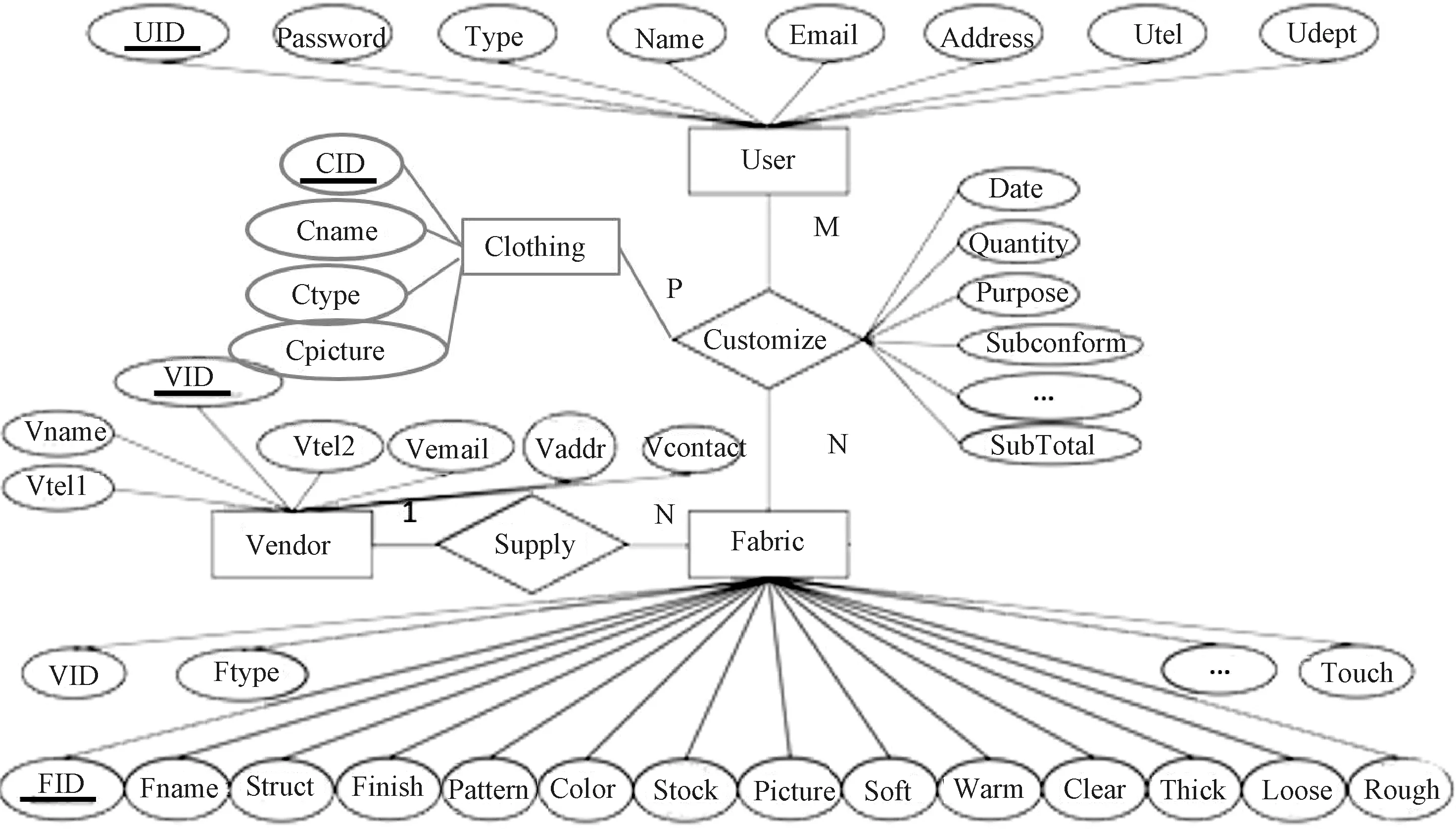
Fig. 2 Entity-Relation(ER) diagram of garment fabric database system
3.2 Logical design of garment fabric database
In logical design process, the four entities of “User”, “Fabric”, “Clothing”, and “Vendor” are transformed into four relationships respectively. “User” customizes “Fabric” and “Clothing”, in which the association of “Customization” belongs to connection of “M:N:P”. Therefore, the connection of “Customize” should be converted into a new relationship. The new relationship is called “UserFeedback”. Considering that the same user may customize the same kind of fabric and clothing for many times, a new data field should be added as the primary key of “UserFeedback”, which is named “UFID” and must be unique. The relationship “UserFeedback” also includes the user’s subjective evaluation data of the fabrics.
The relationship between “Fabric” and “Vendor” is “supply”, which belongs to connection type of “1:N”. Every kind of fabrics has a unique number, and only comes from one vendor. Each vendor can produce a variety of fabrics. Therefore, as for connection “Supply”, we only need to add the primary key of the vendor to the relationship “Fabric”, without generating a new relationship.
To sum up, there are four relationship models derived from the E-R diagram, which are shown as follows.
Relationship1:FabInfo
FabInfo (FID, VID, Fname, Ftype, Fstruct, Ffinish, Fprocess, Ffashion, Fprocess, Fpattern, Fcolor, Fstock, Picture, FCW, FT, FCRR, FCAR, FRAR, FTCC, FTCR, FQmax, FBAR, FBW, FSFC, FSRA, FSRW, FTheoSoft, FTheoWarm, FTheoSmooth, FTheoHand)
Relationship2:VendorInfo
VendorInfo (VID, vendor name, vendor phone number 1, vendor phone number 2, vendor email, vendor address, vendor contact person)
Relationship3:UserInfo
UserInfo (UID, password, user type, user name, user department, user phone number, user email address, user address)
Relationship4:Clothing
Clothing (CID, Cname, Ctype, Cpicture)
Relation5:UserFeedback
UserFeedback (UFID,UID,FID,CID,UFdate, UFamount, UFprice, UFdeliver, UFpayment, UFstatus, UFSubSoft, UFSubWarm, UFSubSmooth, UFSubHand, UFcomment)
4 Garment Fabric Database Creation and UI Design
4.1 Database table design
Garment fabric database named as FabinfoSystem contains five tables: FabInfo, VendorInfo, UserInfo, Clothing, and User Feedback. The structures of five tables are shown in Tables 2-6.
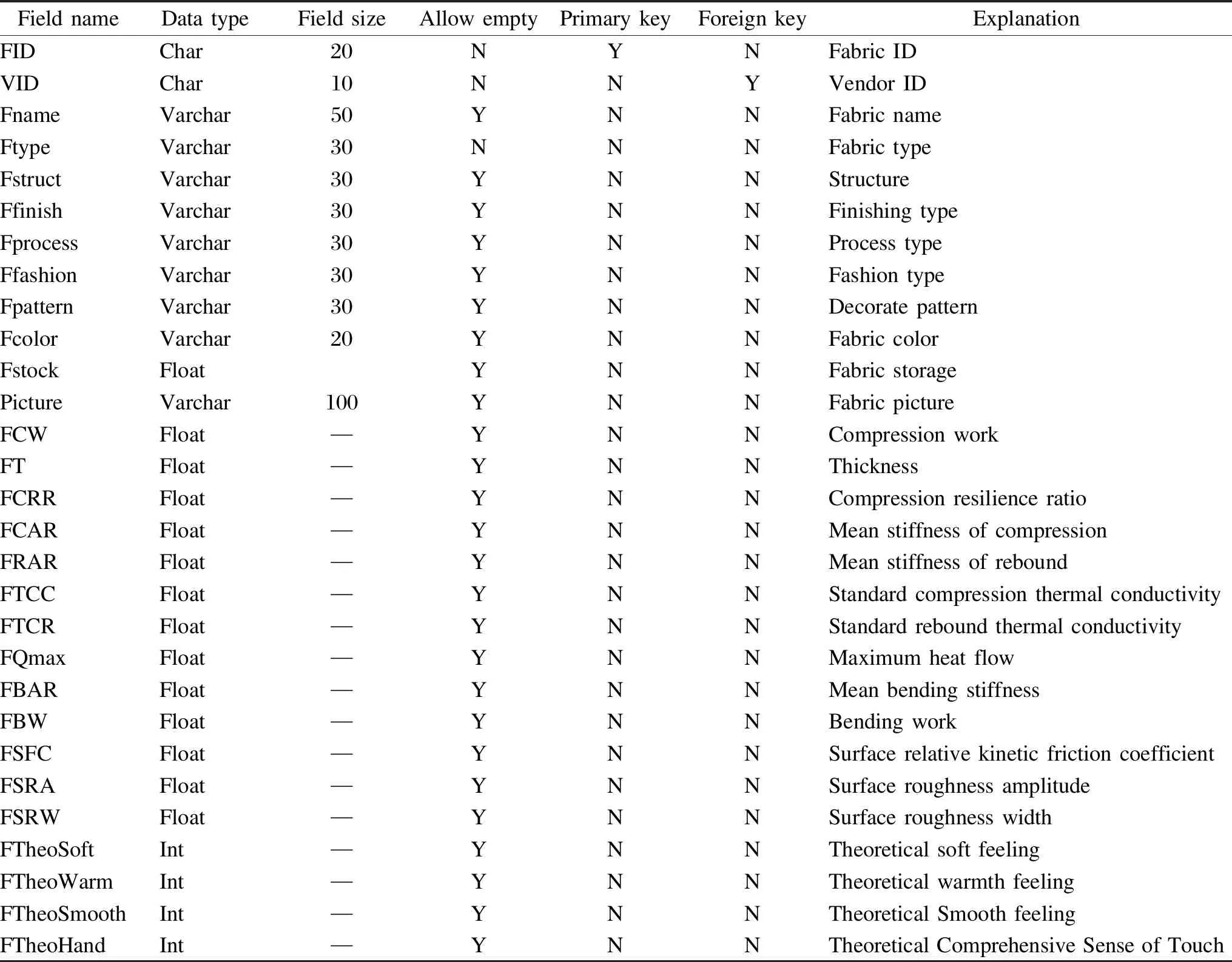
Table 2 Structure of FabInfo

Table 3 Structure of VendorInfo

Table 4 Structure of UserInfo

Table 5 Structure of Clothing
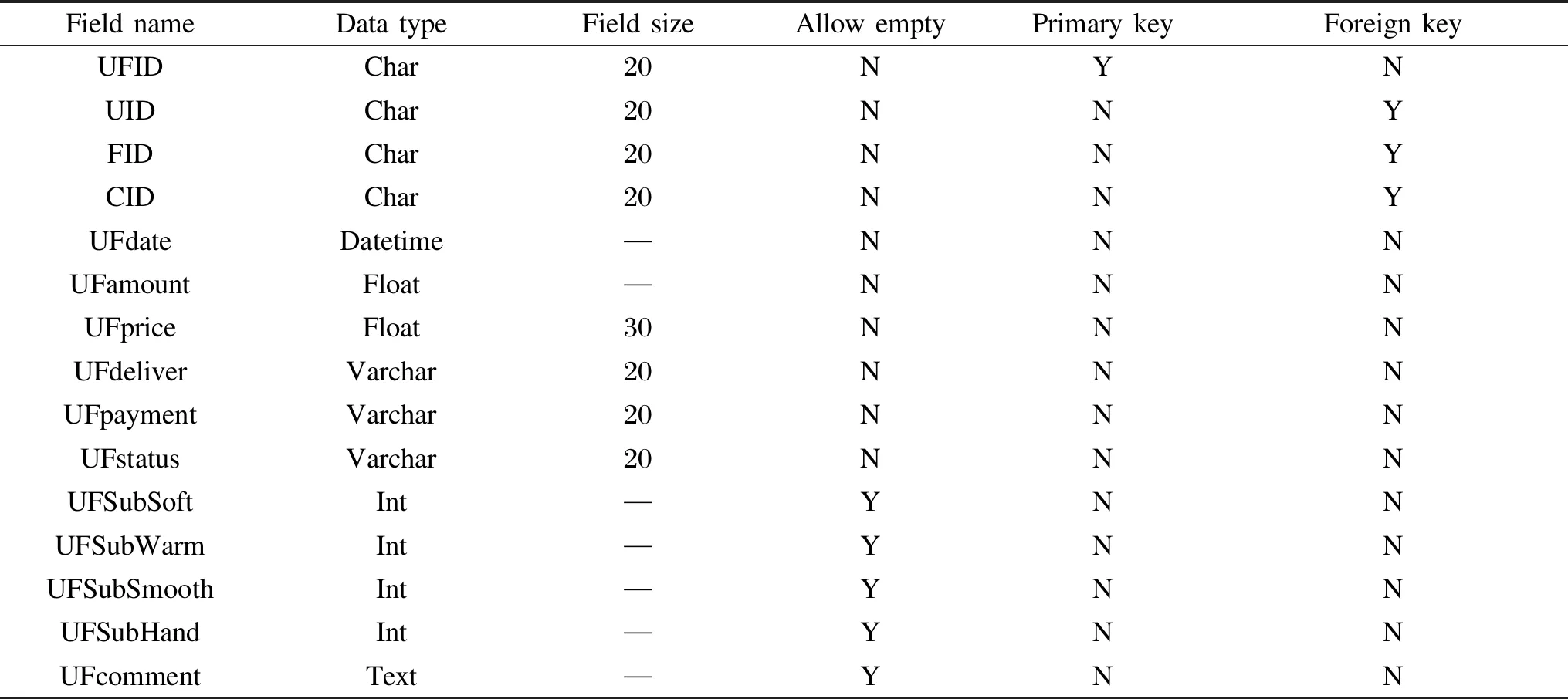
Table 6 Structure of UserFeedback
4.2 Database diagram of FabinfoSystem
Tables 2-6 are connected through the foreign keys in the FabinfoSystem database. The field “VID” is the foreign key in the table FabInfo, which refers to the field “VID” in the table VendorInfo. Three foreign keys exist in the table of Userfeedback, and their specific roles are respectively as follows: “UID” connects UserFeedback table and UserInfo table; “FID” connects UserFeedback table and FabInfo table; “CID” connects UserFeedback table and Clothing table. The relationship diagram of the five tables is shown in Fig. 3.
4.3 UI design of garment fabric database
The UI of FabinfoSystem includes login interface, main window, user management interface, fabric information management interface, feedback management, garment fabric query interface, and so on. The UI of fabric information management is the core of the system, which is shown in Fig. 4. The detail information of every fabric can be input into the system, in which the fabric basic information can be modified or deleted. But, if the fabric has been purchased or used by users, it cannot be deleted, because the operation of deleting will destroy the integrity of data.
The UI of fabric information query is shown in Fig. 5, in which all kinds of users can query fabric information through a combination of many conditions. Many kinds of query criteria are provided, which are separately from each other, such as fabric type, organizational structure, finishing method, technological style, popular style, fabric pattern, fabric color, and subjective evaluation.

Fig. 3 FabinfoSystem database relationship

Fig. 4 Fabric information management

Fig. 5 Complex exploring of fabric
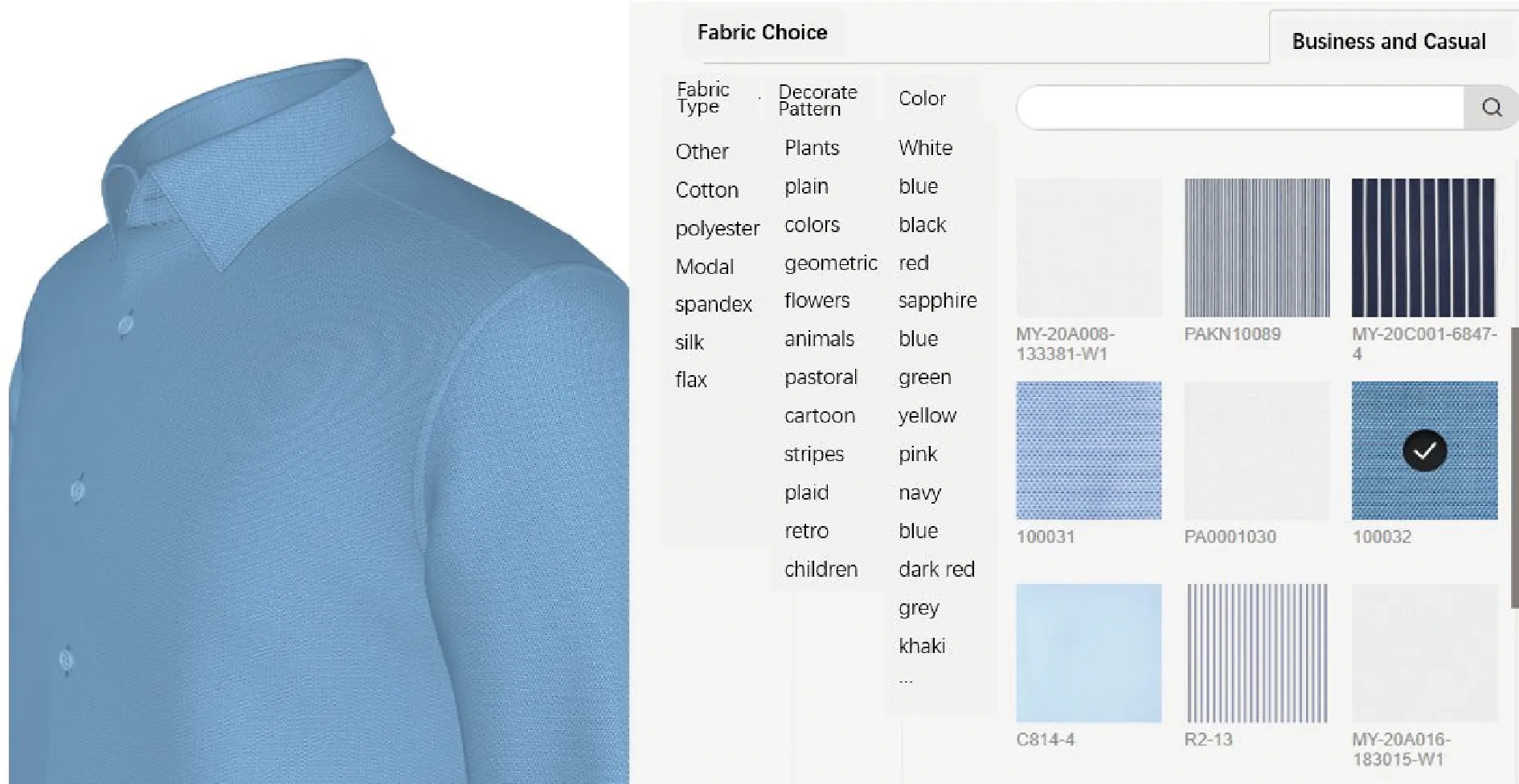
Fig. 6 UI of fabric database in the personalized customization system
The user can select all of the criteria or select some of them to execute query operation. When a kind of target fabric is chosen, there will be a link to the personalized customization system. Figure 6 illustrates the application interface of fabric database in the personalized customization system, which is only a prototype system not developed in FabinfoSystem.
5 Conclusions
The performance characteristics of garment fabric and the classification of different dimensions are analyzed, and the main performance parameters and subjective evaluation parameters are extracted. Based on the above, for the personalized customized garment, the functional design, and conceptual design, logical design of the garment fabric database system is carried out. the UI designing of some core interfaces are provided. This system not only has the objective characteristics of the fabric, but also has many subjective evaluation attributes, which has great significance to designers, consumers, and garment vendors, and will promote the development of garment digitization. Moreover, the subjective evaluation data of users will be collected through the system, which can be applied to further optimize the subjective evaluation model.
Further research can be carried out from the following aspects: (1) integration of fabric database into the garment customization production system; (2) optimization of the subjective evaluation models of fabrics (soft/hard, smooth/rough, cold/warm,etc.).
猜你喜欢
杂志排行
Journal of Donghua University(English Edition)的其它文章
- Classification of Preparation Methods and Wearability of Smart Textiles
- Computer-Based Estimation of Spine Loading during Self-Contained Breathing Apparatus Carriage
- Click-Through Rate Prediction Network Based on User Behavior Sequences and Feature Interactions
- Predictive Model of Live Shopping Interest Degree Based on Eye Movement Characteristics and Deep Factorization Machine
- Object Grasping Detection Based on Residual Convolutional Neural Network
- Time Delay Identification in Dynamical Systems Based on Interpretable Machine Learning
